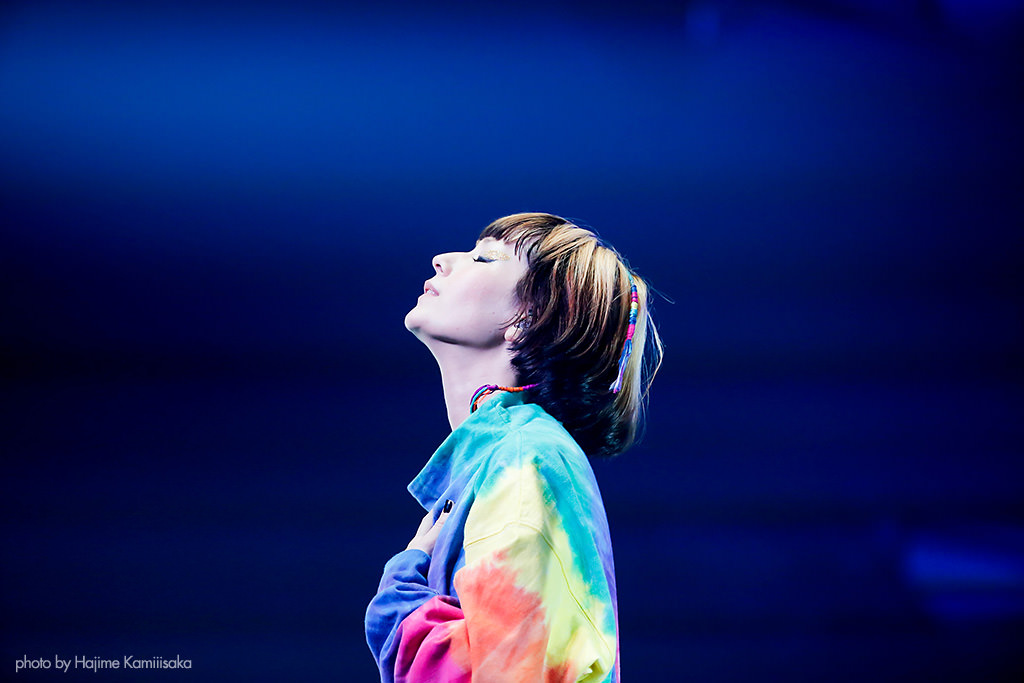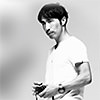Pro Tips for Live Concert Photography (3): Capturing the Atmosphere of a Live Performance
Hajime Kamiiisaka shares with us some in-depth tips for shooting live concert photos that leave a lasting impression in Part 3 of this live concert photography series. Adding that little finesse to how you compose shots, pick angles and capture details will show in your photos. Try getting your best-looking shot as you adapt spontaneously to the excitement of a live concert. (Reported by: Hajime Kamiiisaka)

f/16, 1/30 sec., ISO 2500
Capture a moment that highlights the artist
Once you have grasped the shooting techniques covered in Part 1 and Part 2 to a certain degree, turn your attention to composing your shot. Once you include instruments and drums, and stage effects such as smoke in the background of your frame, the atmosphere of the live concert image is greatly enhanced.

Including the band in the background in this shot conveys the atmosphere of the live concert.
When photographing a single artist, it is easier to compose the shot in the portrait orientation. Set the focus point somewhere within the area you want to capture—it does not necessarily have to be on the face of the artist. Shoot to capture a section of a scene while excluding unnecessary subjects from the frame, and you will get a composition that is just nice. In addition, try adjusting the shutter speed in accordance with the subject’s movements.

f/4.5, 1/50 sec., ISO 2500
It is fine even if you do not capture a full body shot of the artist. Capturing the sections you want to depict is one of the techniques used in live concert photography.
Check out the venue before the live concert itself to visualize what kind of shots you can frame and capture in the portrait and landscape orientations, such that during the actual shoot, you will be able to compose your shot calmly.
Tip: Crop the images if all else fails
Although I do not highly recommend this, if the shooting location or equipment prevents you from getting the shot you wanted, you could crop your images during post-processing. One of the joys of photography is getting a shot almost just like how you visualized it. Through trial and error, you will get better at selecting the equipment and shooting locations for your next live concert photoshoot.
Shoot boldly from a low angle to get an impactful shot
If the only location you can shoot from is lower than the stage height, challenge yourself to a low-angle shot that pushes the limits. Using the wide-angle end of a zoom lens to capture as wide a scene as possible will make it easier to include both the artist and the stage backdrop in the frame. It would be interesting if you incorporated the light radiating from the stage ceiling to capture a distinctive shot. I personally use a fisheye lens quite often to capture a wide variety of shots rich with live atmosphere.

Don’t give up even if the shooting locations restrict you. Using bold compositions will convey the energy of the live concert.
Shooting from a low angle makes it easier to capture the face of guitarists or other artists who tend to tilt their heads downward as they perform. A low camera angle also results in more impactful shots of instances such as when an artist jumps.
Confused about the difference between camera position/level and camera angle? Go to:
Camera FAQ #7: What is the Difference between Camera Position (Level) and Camera Angle?
If you shoot from a high angle, you can include the entire width of the stage in your shot
When shooting from a high angle, make a conscious effort to capture the overall atmosphere of the venue. You will be able to portray the size of the crowd, and also capture the drummers and keyboardists further behind, which are usually difficult to shoot from other angles. Capturing performers standing on the stage is an example of a shot that can only be photographed from a higher position.

f/2.8, 1/160 sec., ISO 2500
Shooting from a high angle, you can depict the overall atmosphere of the venue. Being able to capture the entire width of the stage is another plus.
An interesting aspect to live concert photography is the large amount of freedom you have for methods of photographic expression. Enjoy trying to get photos that you are satisfied with despite being restricted in terms of shooting locations. After several tries, you will begin to understand which angles suit you best.
Capture the vibrant colours and textures of the artist’s signature costumes
Capturing the vibrancy of the artist’s costume and accessories is another technique to live concert photography. Whether or not the artist is cast in flattering lighting is key. If the artist happens to be in lighting that looks natural, the texture of a costume will show even in a close-up shot. Shoot at an f-number of f/5-f/5.6 or higher and you will be able to depict the details of the costume’s textures.

If you want to depict the details on a costume, observe the lighting effects and aim to get a shot when the lighting looks most natural.
Take note that it is difficult to bring out the texture of the costume when it is cast in strong lighting such as when there are red or blue lighting effects. If possible, determine in advance what costume the artist will be wearing if possible. On the day of each live concert, I never forget to go backstage to find out when the artist will be wearing which costume during the event.
Gain as much experience as possible with live concert photography
There is nothing close to a live concert in everyday life, and a live concert venue is a unique shooting location with a number of conditions that are unfavourable to photography. The entire venue is dark, lighting colours and angles change dramatically, and subjects move quickly. You cannot predict what will happen next.
Taking your camera along for actual live concerts is the quickest way to get better at live concert photography, since it is difficult to practise live concert photography with other subjects. One way would be to ask street musicians or friends who play in an amateur band if you can photograph them. Don’t hesitate to request, and if you ask nicely, performers may just give you permission to photograph them. [Or you could take part in a Canon Photo Party. Click the link to find out more.]
You can also practise shooting steadily at night while minimising camera shake, and study live concert photographs online taken by others while recalling in your mind how you shoot live concerts. Those who practice diligently to deal with the unforeseeable circumstances during live concert photography will be able to shoot more professionally.

f/4, 1/100 sec., ISO 1600
Receive the latest updates on photography news, tips and tricks by signing up with us!

Entered Epic/Sony Records in 1993, joining the design production division after gaining experience as a promoter and in A&R. Left in 2002 to become an assistant to fashion photographer JFKK, before striking out to take on photography assignments on his own. Since then, he has been active mainly in the commercial fashion, film, music and visual arts scenes.

































